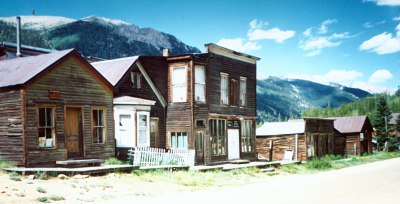Article by Clint Driscoll
Historic preservation – July 2003 – Colorado Central Magazine
THE POTENTIAL for destruction of historically important districts and structures exists all over Central Colorado, and emotions run deep when a proposed or real action threatens such buildings or areas. As Stella Hosmer Bailey wrote in her 1985 history, The Charisma of Chalk Creek:
“The destruction infuriated the local people … the sun-scorched dilapidated structures of Romley were treasured as slowly disintegrating links to the past … their razing was a desecration, an outrage, a violation of the past and the present.”
According to Mike Perschbacher, vice-president of the St. Elmo Property Owners Association, the remains of towns and mine structures in the Chalk Creek area are prime examples of sites in danger and Bailey’s quote accurately reflects the feelings of many local residents.
Perschbacher and Melanie Milam Roth are primarily concerned with the preservation and restoration of the town of St. Elmo and its environs. According to Bailey’s history, the town began life as Forest City in 1878, and was a handy supply point for prospectors working the Chalk Creek drainages and for others using the toll roads to Tincup or up and over the divide into Gunnison country. By 1880 the town’s name had been changed; it had been platted and incorporated as St. Elmo.
The town’s future was assured by the development of the Mary Murphy Mine, the richest producer of gold, silver, lead and zinc in the region and the simultaneous extension of the Denver, South Park and Pacific Narrow Gauge Railroad from Nathrop to haul Mary Murphy ore. The DSP&P’s route continued on up the south fork to Hancock and through the Alpine Tunnel. Mills, smelters, stores, schools and housing sprang up and the town bustled as the Mary Murphy expanded. By 1916, the mine boasted over 7000 feet of drifts, levels and shafts. Major drainage tunnels extended all the way down Pomeroy Gulch to the DSP&P siding at Romley where a huge mill processed ore sent down from upper levels in a 96-bucket, gravity-powered tram.
The Mary Murphy began to fade after World War I and by 1926 the Colorado and Southern Railroad, which had absorbed the DSP&P, ceased service to the Chalk Creek area. Just about everyone left for more profitable climes. But the Stark family stayed on in St. Elmo, buying up cabins and renting them to summer visitors. They also operated the general store, and acquired many of the other commercial and civic buildings and vacant lots in town.
Stella Bailey wrote that because the Starks were year-round residents they were able to prevent the vandalism and souvenir hunting which destroyed so many other mining towns. In fact, during the ’30s and ’40s, Stark family members gained reputations as eccentric, shotgun-wielding guardians, suspicious of just about everyone. Thanks to their efforts St. Elmo remained unique in its state of preservation.
THE LAST STARK died in 1960 and the town holdings were bequeathed to a family friend. Since then the property (roughly 75% of the incorporated town according to Perschbacher) has become part of the Milam Family Trust.
Melanie Milam Roth says her family takes their responsibility for the preservation of St. Elmo seriously and has worked with other property owners to make sure the town retains its 1880s style. Overall she believes the St. Elmo Property Owners Association has succeeded, but that doesn’t mean there haven’t been threats.
In the 1960s a corporation known as Consortium B bought up much of the available property in and around St. Elmo with the idea of building a ski resort. According to Perschbacher, the plans called for ski chalets and a log lodge — designs which would have been totally out of character with the Victorian style of the original town — but development was stymied by a drought. Since then Consortium B holdings have been sold off. The Milam Trust bought much of the property and remains the largest landholder.

IN 1981, the American International Metal Company leased the Mary Murphy with the intention of putting it back in production. This time the lessees were defeated by too much snow and gave up the project, but not before destroying the empty buildings and mill at Romley. The company claimed the buildings presented a liability in case any trespassers were injured while exploring them. But that explanation did little to calm the wrath of locals.
The final nail in Romley’s coffin came in the late ’80s with a reclamation project that was designed to ease point source pollution from mine tunnel drainage and tailings run-off which flowed into Chalk Creek. The work destroyed all the cribbing and settling ponds, although Roth says the company diligently preserved portable artifacts that were found. Today nothing can be seen but the precariously tilting loading chutes on the old railroad grade and a few tram pylons marching up Pomeroy Gulch.
“St. Elmo is still in danger of uncontrolled development or uncontrolled environmentalism,” Persch bacher said during a recent interview. “There is no system in place to protect it or the mill and mine sites around it.”
He was quick to qualify his statement, however, insisting he was not against the restoration of mined land or mitigation of pollution but:
“There really needs to be a balance. We lost some unique structures that should have been preserved. Sometimes there are obvious threats and losses that happen all at once, sometimes they are like creeping cancer, little things change until everything is gone.”
Roth agrees. “We have no protection at the town except the good will of most of the property owners and the county zoning laws, but they do not prohibit modern-style construction as long as it meets code.”
Nor is there any way to prevent a property owner from demolishing an old structure to make way for a new one. “St. Elmo is on the Federal Register of National Historic Districts,” Roth said, “but that only protects the town in case a federal project, such as a dam, would threaten it. What the property owners association is hoping for is local protection.”
TO THAT END, Roth and others have been working closely with Chaffee County officials, particularly commissioner Joe DeLuca, whom Roth describes as sympathetic to their wishes. According to Roth, the district’s best protection would be the adoption of district zoning which would control new building size, height and design as well as exterior colors. The zoning would act like a set of covenants and at least provide some county review and citizen input beyond insuring adherence to prevailing building codes.
Perschbacher said no one expects new buildings or renovated structures to utilize rough-sawn wood held together with square nails and coated with lead-based paint. The intent is to mimic the original appearance as much as possible so people can get an idea what old mountain towns were like. He has successfully restored or stabilized a number of buildings in and around town and adhered to modern codes.
Human activity is not the only threat to St. Elmo. On April 15, 2002 a fire caused by faulty wiring in the town hall destroyed the hall and jail, a 1880s frame house, a 1910 log home and numerous artifacts. To add insult to injury, the town’s antique safe which survived the fire was broken open and irreplaceable records were stolen.
AT A SPECIAL MEETING after the fire, the property owners association voted to deed the town hall site and the school house to the Buena Vista Heritage organization. As a non-profit BVH can and will apply for grants to rebuild the town hall and jail and restore the school. Estimated costs for the town hall construction come in at between $175,000 and $200,000. Matching funds are being raised.
Another preservation plan is to lease — at nominal cost — the old hotel and general store with the idea the lessees will restore them and be able to use them as businesses.
It remains to be seen whether preservation efforts will influence new development and environmental restoration and save St. Elmo’s heritage, but there are many individuals willing to give it their best effort.
The Buena Vista Heritage organization continues its fund-raising efforts. On August 17, 2003 an antique and collectibles auction will be held in St. Elmo. Proceeds will go to the many projects sponsored by BVH. Anyone wishing to donate items to the auction can call BVH at 719-395-8458. Proceeds from donated items can be earmarked for the St. Elmo Town Hall or School Fund, the Turner Homestead Fund, the Depot fund or the general fund.

BVH would also like to retrieve the records stolen after the St. Elmo fire. They can be returned, no questions asked, to the museum in Buena Vista, 506 E. Main St.
Clint Driscoll lives and writes in Buena Vista, where he once served as mayor.

